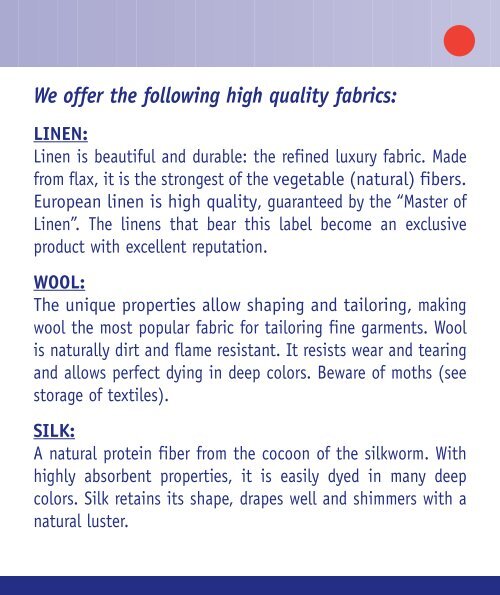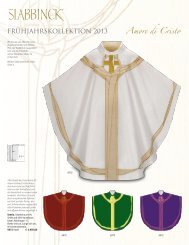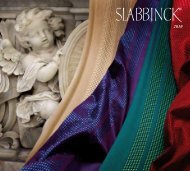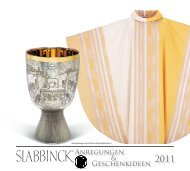We offer the following high quality fabrics: - Slabbinck
We offer the following high quality fabrics: - Slabbinck
We offer the following high quality fabrics: - Slabbinck
Create successful ePaper yourself
Turn your PDF publications into a flip-book with our unique Google optimized e-Paper software.
<strong>We</strong> <strong>offer</strong> <strong>the</strong> <strong>following</strong> <strong>high</strong> <strong>quality</strong> <strong>fabrics</strong>:<br />
LINEN:<br />
Linen is beautiful and durable: <strong>the</strong> refined luxury fabric. Made<br />
from flax, it is <strong>the</strong> strongest of <strong>the</strong> vegetable (natural) fibers.<br />
European linen is <strong>high</strong> <strong>quality</strong>, guaranteed by <strong>the</strong> “Master of<br />
Linen”. The linens that bear this label become an exclusive<br />
product with excellent reputation.<br />
WOOL:<br />
The unique properties allow shaping and tailoring, making<br />
wool <strong>the</strong> most popular fabric for tailoring fine garments. Wool<br />
is naturally dirt and flame resistant. It resists wear and tearing<br />
and allows perfect dying in deep colors. Beware of moths (see<br />
storage of textiles).<br />
SILK:<br />
A natural protein fiber from <strong>the</strong> cocoon of <strong>the</strong> silkworm. With<br />
<strong>high</strong>ly absorbent properties, it is easily dyed in many deep<br />
colors. Silk retains its shape, drapes well and shimmers with a<br />
natural luster.
COTTON:<br />
The principal clothing fiber of <strong>the</strong> world. The cotton fiber is<br />
from <strong>the</strong> cotton plant’s seed pod. Cotton is cool, soft and<br />
comfortable. Since it wrinkles, polyester is sometimes added<br />
to produce wash and wear properties.<br />
MAN MADE FIBERS:<br />
Made from cellulose (vegetable origin) or a blend of cellulose/<br />
syn<strong>the</strong>tic fibers have been in use since just after <strong>the</strong> first world<br />
war. It now has <strong>the</strong> <strong>quality</strong> of natural fibers. Viscose and rayon,<br />
used in conjunction with polyester, are strong, drape well, have<br />
a soft, silky touch and are easily washable.<br />
SYNTHETIC FIBERS:<br />
Polyester or trevira are fibers of chemical composition.<br />
Technical developments have produced a wide range of <strong>high</strong><br />
performance <strong>fabrics</strong>, with <strong>quality</strong> as good or better than natural<br />
fibers. Added benefits are improved crease resistance,<br />
permanent press and fire protection.
FABRIC CARE<br />
GENERAL: every article has a label with washing instructions,<br />
clearly written in English, using <strong>the</strong> international fabric care<br />
symbols. Check <strong>the</strong> label for proper care instructions, including<br />
<strong>the</strong> water temperature and recommended wash cycle. It is<br />
important to treat stains promptly. The longer a stain is allowed<br />
to set, <strong>the</strong> more difficult it is to remove. Most of our<br />
embroidered garments must be dry cleaned with short<br />
cycle. The necessary fabric is added to all altar cloths to<br />
compensate for shrinkage during first laundering. Due to<br />
varying washing procedures, detergents and water temperatures<br />
<strong>the</strong> fabric may shrink more or less than anticipated. Therefore<br />
all altar cloths are provided with a large (1 1/2 ") hem in order to<br />
adjust as necessary. If hand washed in cold water, <strong>the</strong><br />
<strong>fabrics</strong> will not shrink.<br />
➘ Tips before laundering<br />
• sort all articles by color, keeping white, dark and medium<br />
colors toge<strong>the</strong>r. Lighter <strong>fabrics</strong> may pick up colors from dyes<br />
from darker colors.<br />
• sort delicate <strong>fabrics</strong> from “tougher” <strong>fabrics</strong>.
➘ Tips on washing, drying and pressing<br />
LINEN: gentleness is key when washing linen. Pure soaps,<br />
lukewarm to hot temperatures (30° to 50°C or 85° to 120°F), and<br />
soft water are <strong>the</strong> main secrets for good results. When washing<br />
linen for <strong>the</strong> first time, soak in cold or lukewarm water for a few<br />
hours before washing. Use oxygen-type bleaches for white<br />
linens instead of chlorine bleach, which can cause yellowing.<br />
Be sure to rinse <strong>the</strong> linen completely in clear water to remove<br />
all soap, detergents and residual oils. Once rinse and spin cycle<br />
are complete, linen should be line dried or laid flat to dry. To<br />
keep linens white, sun drying is recommended. Avoid wringing.<br />
If necessary, machine dry at low temperatures. When ironing,<br />
keep linen uniformly damp. Set temperature indicator on your<br />
iron to “linen”. First, iron on wrong side of fabric, <strong>the</strong>n on <strong>the</strong><br />
right side. Linen will always shrink after <strong>the</strong> first laundering.<br />
COTTON: wash exactly as linen. Chlorine bleach and any good<br />
detergent can be used on white cotton. Hot water does not<br />
damage <strong>the</strong> fibers.<br />
SILK: dry cleaning is preferred, since laundry detergents may<br />
adversely affect silk <strong>fabrics</strong>.
WOOL: some, but not all wools are washable. Check <strong>the</strong> label<br />
carefully to determine if an item is washable. If not washable,<br />
take garment to a reputable dry cleaner. If washable, wash by<br />
hand or in machine using wool wash cycle (lukewarm 30°C/85°F)<br />
with a detergent designed for wool washing. Fill machine<br />
no more than 1/3 full. Lay articles flat or hang to dry. If<br />
ironing is required, use wool setting. Avoid pressing wool when<br />
completely dry. Whenever possible, press on wrong side of<br />
fabric, or use pressing cloth to avoid a shine. For hand washing,<br />
use lukewarm water. Because wool is <strong>high</strong>ly absorbent, wash<br />
immediately without soaking. Rinse well in lukewarm water,<br />
because wool “fears” temperature changes.<br />
BLENDED MAN-MADE FIBERS AND SYNTHETICS:<br />
machine wash with permanent press cycle, lukewarm water<br />
(maximum 30°C/85°F). Add fabric softener to <strong>the</strong> final rinse<br />
cycle. Hang to dry or machine dry at low temperatures for short<br />
cycles. Always remove articles as soon as tumbling is complete.<br />
If ironing is required, used a moderately warm setting.
LABEL WITH CLEANING INSTRUCTIONS<br />
Every article has a lable indicating cleaning instructions<br />
with symbols.<br />
Washing:<br />
Bleaching:<br />
Dry cleaning:<br />
Ironing:<br />
= washing to indicated temperature.<br />
= NO washing.<br />
= bleaching.<br />
= NO bleaching.<br />
= all solvents except trichloroethylene.<br />
= ONLY petroleum.<br />
= according to indicated temperature.
www.slabbinck.com
REMOVING STAINS<br />
SOFT DRINKS:<br />
Remove <strong>the</strong> sugar by blotting with clean cloth soaked<br />
in warm water. Then repeat, using alcohol.<br />
COFFEE - TEA:<br />
<strong>We</strong>t, rub with detergent. Soften old stains with<br />
glycerine, <strong>the</strong>n wash with biological detergent.<br />
GRASS:<br />
Rub gently with a piece of cloth dipped in a mixture<br />
of alcohol and ammonia, <strong>the</strong>n wash.<br />
FATS:<br />
Treat with dry cleaning fluid, petrol or o<strong>the</strong>r solvent,<br />
cover with talcum powder to avoid “halos”, brush well<br />
and wash.<br />
INK:<br />
Pat <strong>the</strong> reverse side with alcohol, placing an<br />
absorbent layer under <strong>the</strong> fabric, <strong>the</strong>n rinse with<br />
water and neutral detergent.
WINE OR FRUIT:<br />
Immediately blot with paper tissue. Rub fresh stain<br />
with salt impregnated with lemon juice and wash.<br />
BLOOD:<br />
Rinse immediately with cold water, <strong>the</strong>n wash.<br />
On dry stains use 3% hydrogen peroxide and a little<br />
ammonia.<br />
SWEAT:<br />
Use water and vinegar or alcohol and ammonia,<br />
<strong>the</strong>n rinse. For yellow stains, use 3% hydrogen<br />
peroxide.<br />
WAX:<br />
Remove excess wax, <strong>the</strong>n press with iron between<br />
layers of tissue to absorb <strong>the</strong> melted wax. Launder<br />
as usual.
STORAGE OF TEXTILES<br />
STORAGE:<br />
Use only acid-free and archival-safe packing materials<br />
for storage. These storage materials are readily<br />
available from office supply stores. Do not use plastic,<br />
since this can trap moisture and cause mildew or<br />
yellowing of <strong>fabrics</strong>. Storage in basements, attics and<br />
garages is not recommended, because of extreme temperatures,<br />
humidity, grease and o<strong>the</strong>r undesirable<br />
fumes. The ideal storage temperature is approximately<br />
20°C/75°F, with 55% humidity. Wrinkles can often be<br />
removed from stored items by hanging in <strong>the</strong><br />
bathroom and allowing <strong>the</strong> steam from hot shower to<br />
relax <strong>the</strong> wrinkles. After steaming, allow <strong>the</strong> garment<br />
to hang overnight. Any remaining creases can be<br />
gently pressed out.
MOTH PROTECTION:<br />
Moths don’t eat wool; only <strong>the</strong> larvae are wool eaters.<br />
If you notice a pepper-like sandy debris on <strong>the</strong> floor<br />
and in <strong>the</strong> storage drawers, you may have a serious<br />
moth infestation. To eliminate any insect activity, <strong>the</strong><br />
article should be completely dry cleaned or washed<br />
and dried. It is important that all articles stored in<br />
<strong>the</strong> same place be treated. The storage area should be<br />
cleaned and disinfected. When storing cleaned cloths,<br />
<strong>the</strong> addition of moth balls serves as a repellent of<br />
insects, or a moth-proofing treatment is required.<br />
Testing has proven <strong>the</strong>re is no permanent moth-proofing<br />
treatment.
FABRICS AND TEXTILE CARE












